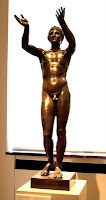After a brief stop at the Kazan Cathedral to watch part of a Russian sung mass and to pay our respects to Field Marshal Kutuzov, the one who defeated Napoleon in 1812, we took the Metro to Peter and Paul Cathedral. The Metro is every bit as deep as the tube in London, so we thought that when we emerged, people might be speaking Chinese.
The Cathedral is inside a fortress on an island in the Neva. Both were built by Peter the Great, although the Cathedral was completed in 1733, eight years after his death. The fortress never saw action except during the Nazi siege, and like most other historic sites, the Russians began to restore the damaged buildings immediately after the war.
 |
| Inside Peter and Paul Cathedral |
Surprisingly, the tombs of the tsars are almost all identical, even those of Peter I and Catherine II. The family of Nicholas II, however, got a whole room to themselves. The building is relatively simple by Russian standards, and it was interesting to see artists at work restoring some of the gold leaf.
 |
| Russian Royal Coat of Arms |
 |
| Spire of Peter and Paul's |
 |
| Looking at the city from the Island |
We did not visit the fortress prisons where various notables stayed when they were out of fashion including Dostoyevsky, Gorky, and Trotsky. We did pause, though, to examine the royal coat of arms over the front gate of the fortress, admire the view of the shoreline across the Neva with the Hermitage and the golden dome of St. Isaac's Cathedral, and, on our walk back over the bridge, to take a last look at the needle-like spire of Peter and Paul's.
A stroll down Nevsky Prospect brought us back to our hotel, where Niko picked us up for a drive to the airport. We were sad to say goodbye to him, but we were relieved to survive the airport, which was almost as primitive and disorganized as the one in Guardalahara. About all that was missing was the chickens.
Some General Thoughts on St. Petersburg
All three of us were somewhat apprehensive about traveling to this terra incognita. Not only did we have a major hassle getting visas to travel here, but also people who had been there or written about it made it sound like East Berlin before the wall came down—KGB stalking us, having to carry our own toilet paper, putting up with sullen and drably dressed natives, and being lucky to find anything edible. We also envisioned a relatively small city that didn't have much going on except for its rich array of royal palaces and fabulous museums.
Well! Things have changed and are continuing to change fast. Yes, we have only glimpsed it from a tourist's perspective—like a Russian judging America from visits to the Empire State Building, the Metropolitan Museum of Art, the Frick, and a stroll down Fifth Avenue. But first of all, the City itself is huge—about 4,850,000 people doing all sorts of things that people do in large cities.
Yes, traffic is as hair-raising as any in Boston or New York, but there is nowhere near as much noise. Older residents, such as those sitting in museums as room guards, may look like fierce versions of Mother Russia, but on the streets, people are smartly dressed and mostly young. Vibrant would be a good way to describe the the place.
Language is definitely a barrier, because none of us took the time to learn the Cyrillic alphabet, but most restaurants—and there are lots and lots of them representing all kinds of cuisines—have English translations. So we got along just fine, especially after discovering an excellent Italian place next to the hotel.
Toilets? They were easy to find and they all had toilet paper! KGB? Who knows? There were lots of sailors in dress uniforms, all of them looking about fourteen years old, but the building next to the Hermitage is the Admiralty, so what would you expect?
The one thing that did meet expectations was the general Russian demeanor. Almost no one smiles. Maybe it's in their genes, but maybe Americans smile too much. What we do know is that if you discount the museum guards, people are generally slim, in-shape, well-dressed, and handsome.
Karin, who has observed how East Germany became absorbed into West Germany, summed it up well. She said that Russia (at least the little we saw of it) is making a similar transition to a world that's modern, fashionable, vibrant, and forward-looking. If so, that bodes well for the future of the world.

















































